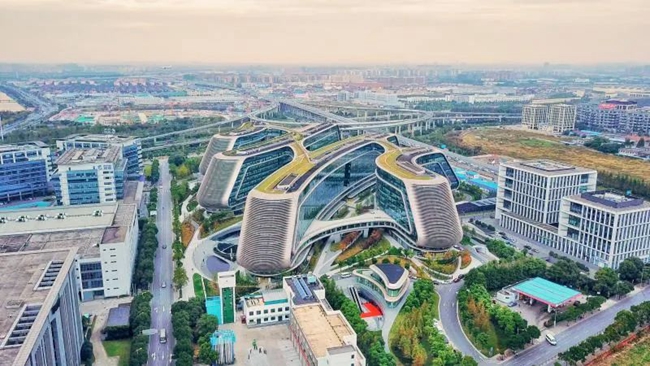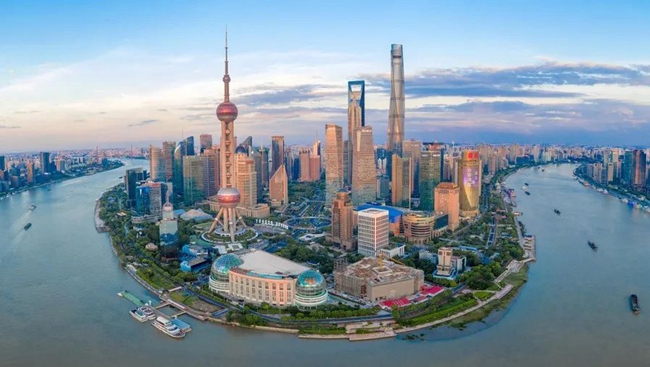Looking at China's economic map, the Yangtze River Delta (YRD) is one of the most economically active regions with the highest degree of openness and the strongest innovation capacity. Closely following the key words "integration" and "high quality", the Yangtze River Delta region's economic agglomeration, regional connectivity and policy synergies have improved significantly, and new breakthroughs in integrated development have been made.
Integration of Science and Technology Innovation
When you open the "Jiuzhang III", which is a new world record in optical quantum information technology, you will see several cylindrical "small refrigerators", in which a number of metal modules slightly larger than a fingernail cap with fiber optic "pigtails" are carefully arranged. "The metal module.
Shanghai Institute of Microsystems and Information Technology of the Chinese Academy of Sciences researcher You Lixing introduced these modules called superconducting single photon detector, is "nine chapters of the third" in the capture and identification of a single photon "eyes", born in Shanghai, to Zhejiang package, and then to the Anhui Province Application, each single-photon detector will experience a collaborative innovation journey in the Yangtze River Delta.
You Lixing said, Shanghai has a very strong scientific and technological strength, Zhejiang Jiashan has the cost advantage of manufacturing, Anhui Hefei in the continued exploration of quantum science and technology front. Yangtze River Delta synergistic innovation continues to help quantum science and technology to climb the peak of science and technology, the team will continue to promote the evolution of single-photon detection technology around the application needs.
Located in Hangzhou City, Zhejiang Province, Qiantang (new) District of China Pharmaceutical University (Hangzhou) Institute of Innovative Drugs, staff are skillfully operating instruments and equipment. The institute is jointly built by China Pharmaceutical University (CPU) and Qiantang District. CPU plays to its own strengths while actively linking industrial elements and resources in the Yangtze River Delta, and has set up research institutes in Qiantang (New) District of Hangzhou and Suzhou, respectively, to provide services for local enterprises.

China Pharmaceutical University (Hangzhou) Innovative Drug Research Institute, deputy director of the research department Qi Xiaole said, Suzhou biomedical industry has obvious advantages, mainly in health and testing reagents. Qiantang (New) District has a sound supporting base for biopharmaceutical industrialization, with high-end preparations as the direction. Relying on the innovation cluster advantage of the biopharmaceutical industry in the Yangtze River Delta, the institute has built several high-powered technology platforms and R&D service centers.
From original innovation in the laboratory, to accelerate the transformation of results, to facilitate the "unveiling of the list of commanders", incubation and support for entrepreneurship ...... synergistic innovation, so that the elements in the free flow of the Yangtze River Delta, the output of innovation activities to form a "geometric effect The output of innovation activities has formed a "geometric effect". Nowadays, Shanghai, Suzhou, Zhejiang and Anhui are ranked among the top ten in China in terms of regional innovation capacity, and the "Yangtze River Delta model" of collaborative innovation has emerged.
Integration of Industrial Collaboration
In January this year, the first domestic large-scale cruise ship "AIDA - Magic City" officially opened the commercial maiden voyage. At present, the second domestic large cruise ship is under construction in Shanghai.
Zhou Qi, deputy general manager of Shanghai Waigaoqiao Shipbuilding Co., Ltd. introduced that in the domestic procurement of parts, suppliers from the Yangtze River Delta accounted for more than 60%. The company also united with a university in Jiangsu, successfully developed a large-scale thin plate leveling electromagnetic leveling equipment.
In recent years, Anhui Province and the Yangtze River Delta G60 Science and Innovation Corridor cities collaborate to promote the flow of technology elements and accelerate the construction of industrial parks.
Relying on the Yangtze River Delta G60 Science and Innovation Corridor, Anhui focuses on ten emerging industries, focuses on the layout of a number of cross-provincial collaboration of the "innovation enclave", and actively builds industry-recognized high-end R & D and innovation platforms, and promotes the policy, talent, technology and other aspects of the cross-regional cooperation at a deep level. At the same time, the enterprise as the main body, market-oriented, and constantly promote the deep integration of production, learning, research and use, and actively benchmark Shanghai, Suzhou and Zhejiang advanced regions, increase scientific and technological innovation and collaborative research efforts, establish a series of innovative development system, and constantly optimize the science and innovation ecosystem, and promote the construction of science and technology innovation community of the Yangtze River Delta to a new level.
Zhang Xiang, marketing director of Hefei Zhongke Environmental Monitoring Technology National Engineering Laboratory Co., Ltd. introduced that relying on the Hefei Institute of Materials Research of the Chinese Academy of Sciences, the company has a lot of scientific and technological innovation results, but the promotion of transformation is a problem. After the local promotion of the Yangtze River Delta G60 Science and Innovation Corridor Environmental Industry Cooperation Demonstration Park settled in Hefei, through the organization of relevant exhibitions, technical seminars, academician summits, etc., and actively promote cross-regional docking, the company in the R & D cooperation and industrial landing on a new path.
Integration of Financial Supply

Small size, light weight, high efficiency, is to significantly improve the performance of new energy vehicles, industrial and other areas of electric drive system of the key three elements. Headquartered in Songjiang District, Shanghai, disk hub power, because of this "technical code", in the past three years, annual sales from 40 million yuan to 300 million yuan. Recently, the company obtained a fund for the transformation of scientific and technological achievements in the G60 Science and Innovation Corridor of the Yangtze River Delta, and will further develop new products and new markets.
Pan Cunwei, assistant to the president of Panhub Power, said that the company has set up its headquarters in Songjiang, Shanghai, and its manufacturing base in Jinhua. The Yangtze River Delta region is China's automotive industry highland, and now it has become one of the most advantageous regions for the development of new energy vehicles, with a complete industrial chain, as well as huge market demand and export convenience.
Aiming at the investment attributes of "hard technology", the Yangtze River Delta region has explored the integration of financial supply. Up to now, as the first inter-regional science and technology achievement transformation fund in the Yangtze River Delta that undertakes national strategic tasks and is co-financed by nine places, the cumulative amount of the G60 Fund has reached 542 million yuan. Among them, 29% are high-end equipment, 21% are new materials and 8% are biomedicine.
Jia Zhanfeng, deputy director of the Yangtze River Delta G60 Science and Innovation Corridor Joint Office and director of the Innovation Research Center, said that the G60 Fund leverages more social capital through the cross-regional linkage mechanism, injects strong kinetic energy into the transformation of scientific and technological achievements, promotes the construction of advanced manufacturing industry clusters, and accelerates the formation of a regional economic pattern with complementary advantages and high-quality development in the nine regions.
From 2018 to 2023, the G60 Science and Innovation Corridor in Yangtze River Delta will not only extend and expand in geographic space, but also enhance the quality and energy of the innovation ecology and collaboration network, and the added value of strategic emerging industries will increase from 11.5% to 15% of GDP. The unique "innovation corridor" economy has provided a strong impetus for the Yangtze River Delta to participate in the competition among global city clusters.

